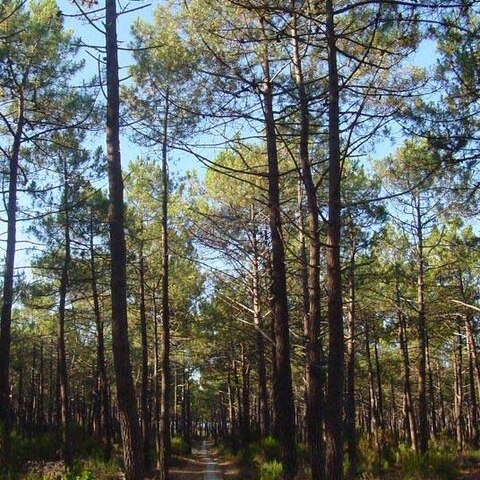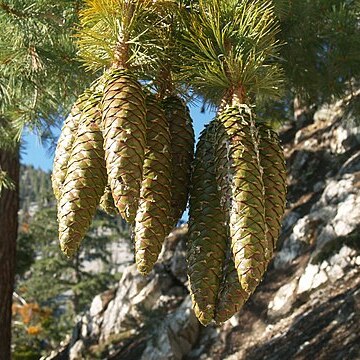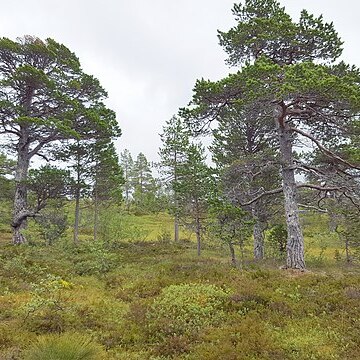Trees or shrubs aromatic, evergreen; crown usually conic when young, often rounded or flat-topped with age. Bark of older stems variously furrowed and plated, plates and/or ridges layered or scaly. Branches usually in pseudowhorls; shoots dimorphic with long shoots and short shoots; short shoots borne in close spirals from axils of scaly bracts and bearing fascicles of leaves (needles). Buds ovoid to cylindric, apex pointed (blunt), usually resinous. Leaves dimorphic, spirally arranged; foliage leaves (needles) (1--)2--5(--6) per fascicle, persisting 2--12 or more years, terete or ± 2--3-angled and rounded on abaxial surface, sessile, sheathed at base by 12--15 overlapping scale leaves, these (at least firmer basal ones) persisting for life of fascicle or shed after first season; resin canals 2 or more. Pollen cones in dense, spikelike cluster around base of current year's growth, mostly ovoid to cylindric-conic, tan to yellow, red, blue, or lavender. Seed cones maturing in 2(--3) years, shed early or variously persistent, pendent to ± erect, at maturity conic or cylindric, sessile or stalked, shedding seed soon after maturity or variously serotinous (not opening upon maturity but much later); scales persistent, woody or pliable, surface of exposed apical portion of each scale (apophysis) thickened, with umbo (exposed scale surface of young cone) represented by a scar (sometimes apiculate) or extended into a hook, spur, claw, or prickle; bracts included. Seeds winged or wingless; cotyledons (3--)6--10(--18). x =12.
Trees or rarely shrubs, evergreen, with regularly whorled branches; branchlets strongly dimorphic: long branchlets bearing scalelike leaves and spreading leaf bundles; short branchlets bearing leaves in bundles of 2-5(-7); winter buds large, with numerous scales. Leaves needlelike, slender or stout, straight or twisted, triangular, flabellate-triangular, or semiorbicular in cross section, stomatal lines several, on 1, 2, or all surfaces, vascular bundles 1 or 2, resin canals 2-10 or more, marginal or median, rarely internal, base enclosed by persistent or deciduous, membranous sheath. Pollen cones usually borne in spikelike clusters at base of 1st-year branchlets, sessile, cylindric or ovoid; pollen 2-saccate. Seed cones pedunculate or subsessile, erect or pendulous, cylindric or ovoid, maturing in 2nd or 3rd year. Seed scales spirally arranged, woody, exposed apex thickened and ridged (the apophysis), with a prominent protuberance (umbo), usually terminating in a spine or prickle, persistent. Bracts minute. Seeds variable in color, shape, and size, winged or not; wing adnate or articulated to seed. Cotyledons 3-18. Germination epigeal. 2n = 24*.
Evergreen monoecious trees or rarely shrubs. Bark smooth or rough, particularly on older trees, peeling in flakes often of very irregular shape. Leaves linear or lanceolate, often with minute serrations, spirally placed, soon replaced by scales in the axils of which appear reduced shoots in the form of bundles enclosed around their base by a sheath of scale leaves, adult leaves in the bundles linear, pungent, needle-like, the cross section of each leaf forming a sector of the circle formed by the entire bundle. Pollen cones numerous, axillary, cylindrical, subtended by a cluster of overlapping scales similar to the foliage bud, microsporophylls scale-like with two inverted pollen sacs. Seed cones terminal on short scaly shoots, more or less cylindrical, consisting of numerous fertile scales which become woody, ripening in the second or third year, the apiculate bract fused with the scale, two inverted ovules on each scale. Seed egg-shaped, with a firm outer shell, usually with an expanded wing which is attached to the broad base of the seed.
Male cones in fascicles at the base of the current year’s growth; female cones woody, maturing at the end of the second or third season and often long-persistent; apophysis (exposed portion of the mature cone-scale) marked by a transverse line or ridge interrupted in the center by a linear to round or quadrate, often elevated or spine-bearing umbo, or the umbo sometimes terminal; evergreen trees or shrubs with dimorphic branches and lvs, the long branches (except in seedlings) bearing only scale-lvs, from the axils of which early appear very short dwarf branches, each bearing a cluster of (1)2–5 needle-like lvs, the cluster surrounded at the base by a bundle-sheath of 1 or more membranous scale-lvs; dwarf branches eventually (after 2–several years) deciduous with the lvs; evergreen trees or shrubs; 2n=24. Nearly 100, N. Hemisphere.
Monoecious trees or shrubs. Shoots dimorphic; long shoots bearing colourless scale leaves with woody decurrent bases; short shoots axillary in scale leaves, bearing dimorphic leaves, regularly deciduous as a unit. Early leaves scarious and colourless, forming a basal sheath around a fascicle of late leaves; late leaves in fascicles of fixed number depending on species, acicular, green. Male cones axillary in same position as short shoots. Female cones terminal on short or very short lateral shoots; scales persistent. Seeds 2, on upper surface of each cone scale; wing sometimes much reduced.



